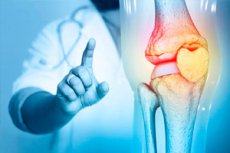Nye publikasjoner
Forskere advarer mot en "tsunami" av artrosetilfeller innen 2050
Sist anmeldt: 02.07.2025

Alt iLive-innhold blir gjennomgått med medisin eller faktisk kontrollert for å sikre så mye faktuell nøyaktighet som mulig.
Vi har strenge retningslinjer for innkjøp og kun kobling til anerkjente medieområder, akademiske forskningsinstitusjoner og, når det er mulig, medisinsk peer-evaluerte studier. Merk at tallene i parenteser ([1], [2], etc.) er klikkbare koblinger til disse studiene.
Hvis du føler at noe av innholdet vårt er unøyaktig, utdatert eller ellers tvilsomt, velg det og trykk Ctrl + Enter.

Slidgikt (OA) er en degenerativ sykdom som rammer vektbærende ledd. Knærne, hoftene, ryggraden og de små leddene i hendene er oftest rammet. To av tre personer over 50 år har knirkende og knirende ledd som forårsaker daglige smerter og redusert mobilitet. Problemet vokser etter hvert som befolkningen eldes og flere mennesker blir stillesittende, overvektige og fete.
Slitasjegikt er også overraskende vanlig blant unge mennesker, spesielt de med usunn livsstil, dårlig kosthold og atletiske unge mennesker som har fått traumatiske leddskader. I alvorlige tilfeller kan leddgikt føre til betydelig uførhet.
Alt i alt er slitasjegikt en kronisk tilstand som krever kontinuerlig behandling for å lindre symptomer og opprettholde leddfunksjon. Tidlig diagnose og passende behandling kan bidra til å bremse sykdomsprogresjonen og forbedre den generelle ledhelsen.
Selv om slitasjegikt rammer mer enn 500 millioner mennesker over hele verden, finnes det ingen behandling eller godkjent medisin for å behandle eller forebygge sykdommen, ifølge Verdens helseorganisasjon. De eneste tilgjengelige behandlingene er smertestillende midler, betennelsesdempende medisiner og total leddprotese.
Dette fremhever sykdommens samfunnsmessige konsekvenser og behovet for større tiltak for å utvikle mer effektive behandlinger som kan brukes til å behandle og forebygge slitasjegikt.
Nytt konsortium skal løse problemet
Innen 2050 vil én av tre personer lide av slitasjegikt, og det finnes for øyeblikket ingen kur. Derfor har NetwOArk COST Action – det åpne europeiske nettverket for slitasjegikt – som mål å opprette et europeisk slitasjegiktsamfunn. Nettverket, som ble lansert i oktober 2022, samler pasienter, klinikere og forskere fra akademia og industri i 17 land.
NetwOArk har som mål å skape et inkluderende nettverk og et nytt samfunn som samler alle viktige interessenter, inkludert pasienter, pasientorganisasjoner, forskere, leger, farmasøytiske selskaper, små og mellomstore bedrifter, produsenter av medisinsk utstyr og beslutningstakere.
«COST Actions gir oss, som et fellesskap av mennesker som er interessert i artrose (pasienter, forskere, klinikere), muligheten til å skape et reelt nettverk! Så med NetwOArk er og vil de neste stegene være mulige», sier Corné Baatenburg de Jong, styreleder i NetwOArk.
Dette samarbeidsnettverket fremhever det presserende behovet for å ta tak i dette problemet ved å øke bevisstheten blant publikum og beslutningstakere om alvoret av slitasjegikt og dens innvirkning på samfunnet.
Dette er betimelig og viktig ettersom byrden av slitasjegikt i Europa er enorm, med en «tsunami» av slitasjegikttilfeller som forventes å ramme helsesystemene innen 2050, noe som potensielt kan legge til måneder og år til allerede uakseptabelt lange ventelister for leddprotesekirurgi.
Kommunikasjon er nøkkelen til suksess
«Slitasjegikt er en alvorlig sykdom som representerer en betydelig global byrde og fortsatt er en stor hindring for fri mobilitet i alvorlige tilfeller, noe som resulterer i betydelig sykelighet i den aldrende befolkningen. En av hovedutfordringene er å kommunisere de nyeste forskningsfunnene til pasienter, leger og allmennheten.»
«En annen stor utfordring er å utdanne helsepersonell om de nyeste behandlingsretningslinjene og forskningsfunnene. Hovedmålet til NetwOArk er å samle alle nøkkelaktører og skape et sterkt fellesskap av europeiske forskere dedikert til artroseforskning og klinisk utvikling», sier professor Ali Mobasheri, NetwOArk sin koordinator for vitenskapelig kommunikasjon.
På lang sikt har NetwOArk som mål å overføre denne vitenskapelige kunnskapen til nasjonale pasientorganisasjoner for artrose, klinikere og beslutningstakere for å skape en sterk europeisk forskningsplattform. I tillegg å overføre vitenskapelig kunnskap fra eksperimentell forskning i laboratoriet til privat sektor for å fremheve viktigheten av forebygging og legge til rette for utvikling av nye behandlinger.
For første gang konsoliderer og utvider nettverket innsatsen til nasjonale forskningsprogrammer innen primærhelsetjenesten, revmatologi, ortopedi, folkehelse, smertemedisin, psykologi, farmasi, celleterapi, fysioterapi, ernæring, folkehelse, ergoterapi, epidemiologi og helseøkonomi.
